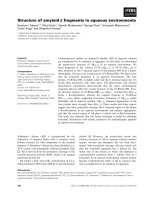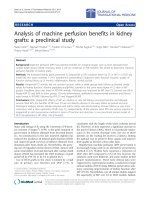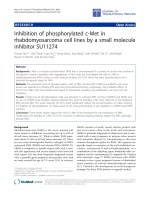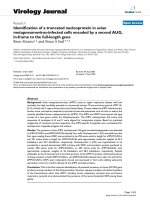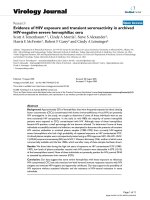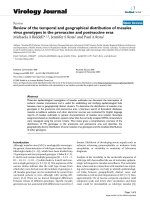Báo cáo sinh học: "Variation of sperm length and in drosophilid species" docx
Bạn đang xem bản rút gọn của tài liệu. Xem và tải ngay bản đầy đủ của tài liệu tại đây (638.5 KB, 11 trang )
Original
article
Variation
of
sperm
length
and
heteromorphism
in
drosophilid
species
D.
Joly
M L.
Cariou
D.
Lachaise
J.R.
David
Centre
National
de
la
Recherche
Scientifi
q
ue,
laboratoire
de
biologie
et
genetique
evolutives,
91198
Gif-sur- Yvette
Cedex,
France
(received
8
December
1988,
accepted
17
April
1989)
Summary -
Sperm
length
was
measured
in
27
drosophilid
species,
and
a
general
survey
of
size
variation
is
presented
for
75
species
for
which
information
is
available.
Mean
length
varies
from
0.113
mm
in
the
D.
obscura
group
to almost 20
mm
in
the
recently
investigated
D.
littoralis;
in
the
latter
case,
sperm
length
is
nearly
6
times
the
male
body
length.
The
huge
interspecific
variability
may
be
estimated
by
considering
the
coefficient
of
variation
(c.v.)
between
species
belonging
to
the
same
taxon.
In
the
genus
Drosophila
the
c.v.
amounts
to
130%
(64
species).
The
average
c.v.
decreases
in
lower
taxa,
being
for
example
96%
in
subgenera
and
61%
in
species
groups.
More
closely
related
species
are
thus
less
divergent,
but
in
any
case
sperm
length
must
be
considered
as
a
fast
evolving
trait,
increasing
or
decreasing.
Individual
measurements
of
sperm
length
within
a
species
generally
provide
a
unimonal,
relatively
gaussian
distribution
(monomorphism).
By
contrast,
13
investigated
species
of
the
D.
obscura
group
exhibited
bimodal
distributions.
This
heteromorphism
may
be
considered
as
a
stable
evolutionary
strategy
in
the
D.
obscura
group.
Drosophila -
sperm
length -
sperm
heteromorphism -
sperm
evolution
Résumé -
Variation
de
la
longueur
des
spermatozoïdes
et
hétéromorphisme
chez
les
drosophilidés.
La
longueur
des
spermatozoïdes
mesurés
chez
27
espèces
de
Drosophilidés
est
étudiée
au
niveau
de
l’ensemble
de
la
famille
(75
espèces).
Les
moyennes
de
longueur
varient
de
0,113
mm
chez
les
espèces
du
groupes
obscura
jusqu’à
20
mm
chez
une
espèce
nouvellement
étudiée,
D.
littoralis;
chez
cette
dernière,
la
longueur
du
spermatozoïde
at-
teint
6
fois
la
longueur
du
corps
de
l’adulte.
L’amplitude
de la
variation
interspécifaque
peut
être
appréciée
en
considérant
le
coefficient
de
variation
(c.v.)
entre
espèces
appar-
tenant
à
un
même
taxon.
Dans
le
genre
Drosophila
(64
espèces
étudiées),
la
valeur
du
c.v.
atteint
130%.
Les
valeurs
des
c.v.
moyens
diminuent
pour
les
niveaux
taxonomiques
inférieurs,
c’est-à-dire
96%
au
niveau
du
sous-genre
et
61 %
pour
les
groupes
d’espèces.
Les
longueurs
de
spermatozoïdes
des
espèces
étroitement
apparentées
sont
relativement
proches
mais
dans
quelques
cas,
il
apparaît
que
ce
caractère
évolue
rapidement,
tendant,
soit
à
augmenter,
soit
à
diminuer.
Les
mesures
de
la
longueur
des
spermatozoïdes
pour
une
espèce
correspondent
généralement
pour
un
individu
à
une
distribution
unimodale,
gaussienne
(monomorphisme).
En
revanche,
les
13
espèces
du
groupe
obscura
montrent
des
distributions
bimodales.
Cet
hétéromorphisme
peut
être
considéré
comme
une
stratégie
évolutive
stable.
Drosophile -
longueur
des
spermatozoïdes -
hétéromorphisme
des
spermatozoïdes -
évolution
des
spermatozoïdes
INTRODUCTION
In
most
Eucaryote
species,
meiotic
reproduction
has
evolved
in
producing
two
sizes
of
gametes,
known
as
the
macro,
or
female
gamete
(oocyte
or
ovum)
and
the
micro,
or
male
gamete
(sperm)
respectively
(Parker
et
al.,
1972;
Power,
1976;
Maynard
Smith,
1978;
Alexander
&
Borgia,
1979;
Parker,
1984).
In
the
macrogamete,
size
variations
between
taxa
are
well
documented
and
incorporated
in
the
evolutionary
theories
of
parental
investment
(Trivers,
1972)
and
life
history
strategies
(Throckmorton,
1966).
By
comparison,
evolutionary
trends
in
the
microgamete
(sperm)
have
re-
mained
neglected.
Indeed,
when
considering
vertebrates
an
overall
uniformity
seems
the
rule,
yet
some
differences
in
sperm
heads
or
tails
have
been
found
in
rabbits
and
rodents
(Friend,
1936;
Beatty
&
Napier,
1960;
Beatty
&
Sharma,
1960;
Woolley,
1971).
In
these,
sperm
with
a
medium
size
flagellum
less
than
0.1
mm
long
are
produced
in
huge
numbers
and
each
gamete
has
an
extremely
low
probability
of
producing
a
zygote.
Sperm
shape,
size
and
ultrastructure
are,
however,
far
more
diverse
among
invertebrates
(Fain-Maurel,
1966;
Afzelius
et
al.,
1976;
Baccetti,
1979;
Sivinski,
1984;
Chauvin
et
al.,
1988)
and
analysing
this
diver-
sity
should
help
to
understand
the
developmental
constraints
and
selective
pressures
which
permitted
or
promoted
the
various
patterns
presently
observed.
In
some
in-
vertebrates,
including
Lepidoptera,
two
or
more
morphologically
and
functionally
different
microgametes
occur
intraspecifically
and
warrant
recognition
of
eusperm
and
parasperm
(Healy
&
Jamieson,
1981;
Jamieson,
1987a).
In
the
present
work,
attention
is
focused
on
the
evolution
of
sperm
length
in
a
monophyletic
dipteran
taxon,
the
family
Drosophilidae.
Drosophila
melanogaster,
generally
considered
as
a
reference
for
this
group,
is
known
for
its
long
sperm
(1.9
mm)
which
is
almost
as
long
as
the
body
of
the
fly
(Cooper,
1950;
Yanders
&
Perras,
1960;
Beatty
&
Burgoyne,
1971;
Gould-Somerot
et
al.,
1974;
Joly,
1987).
However,
at
the
family
level,
D.
melanogaster
sperm
can
appear
very
short
compared
to
those
of
other
species
such
as
for
instance
D.
hydei,
where
it
can
be
4-5
times
(1.4
or
even
1.9
cm)
the
size
of
the
body
of
the
fly
(Hess
&
Meyer,
1963;
Jamieson,
1987b).
Taxonomists
have
long
been
aware
that,
in
the
family
Drosophilidae,
sperm
length
could
be
very
variable
between
species
and
several
papers
have
been
recently
devoted
to
this
problem
(Beatty
&
Sidhu,
1970;
Sanger
&
Miller,
1973;
Gromko
et
al.,
1984;
Sivinski,
1984;
Hatsumi
&
Wakahama,
1986;
Hihara
&
Kurokawa,
1987;
Joly,
1987).
Explaining
such
variations
raises
an
evolutionary
challenge
which
may
be
formulated
as
follows:
if
sperm
length
is
a
fast
evolving
trait,
it
should
exhibit
a
high
genetic
variance
and
a
high
heritability,
at
least
in
some
species;
moreover,
a
rapid
evolution
for
increased
or
decreased
length
would
be
difficult
to
explain
if
the
trait
is
considered
as
neutral,
and
strong
selective
pressures
should
exist
or
have
existed
during
the
process
of
speciation.
In
Drosophila,
intraspecific
genetic
variability
of
sperm
length
is
poorly
docu-
mented
and
presently
available
investigations
have
failed
to
demonstrate
genetic
variance
(Joly,
1987)
or
have
found
only
very
limited
variability
(Beatty
&
Sidhu,
1970;
Sanger
&
Miller,
1973).
The
aim
of
this
paper
is
to
focus
attention
on
in-
terspecific
variations
and
to
present
an
overview
of
what
is
known
in
the
family.
In
the
genus
Drosophila,
sperm
length
can
indeed
be
considered
as
a
fast
evolving
trait
with
a
loose
relationship
with
phylogeny.
In
most
species,
sperm
length
distri-
butions
within
the
individual
are
unimodal
with
a
limited
variability.
However,
in
one
monophyletic
taxon,
the
D.
occurs
species
group,
the
occurrence
of
bimodal
distributions
seems
the
rule
and
we
therefore
argue
here
that
it
corresponds
to
an
evolutionary
stable
strategy
(ESS)
(Maynard
Smith,
1974).
MATERIAL
AND
METHODS
Sperm
length
was
measured
in
27
species,
13
of
which
belong
to
the
obscura
species
group
including
the
two
recently
discovered
East
African
species
(D.
microlabis
and
D.
kitumensis)
(Cariou
et
al.,
1988).
The
source
of
material
of
the
obscura
group
species
investigated
was
the
same
as
in
Cariou
et
al.
(1988)
with
the
exception
of
D.
af
finis
(14012,
014-1)
and
D.
azteca
(14012-0171)
which
were
provided
by
the
Bowling
Green
Stock.
The
eight
species
of
the
melanogaster
subgroup
were
analyzed.
The
source
of
specimens
of
the
melanogaster
complex
species
was
the
same
as
in
Joly
(1987)
while
those
of
the
others
were
the
following:
D.
teissieri
and
D.
yaku.ba
came
from
different
localities
in
Africa
(Gif
Stock);
D.
erecta
(Ivory
Coast,
Gif
220-5)
and
D.
orena
(West
Cameroon,
Gif
188-1).
Other
drosophilid
species
studied
were
D.
bahunde
(Kenya,
Gif
269-4),
D.
bakundjo
(Kenya,
Gif
269-5),
Scaptorrayza
padlida
(Kenya,
Gif
292-2),
Zaprionus
tuberculatns
(West-Africa),
D.
grimshawi
(Hawaii)
and
D.
littoralis
(unknown
Palearctic
origin)
from
the
Bowling
Green
Stock.
The
strains
were
reared
at
21
°C.
Sperm
were
recovered
from
the
seminal
vesicles
of
one
or
several
males.
The
testes
were
isolated
and
opened
in
a
drop
of
saline
solution
and
the
sperm
allowed
to
spread
out.
This
preparation
was
observed
under
a
microscope
with
phase
contrast
optics.
When
the
sperm
had
ceased
to
move,
they
were
traced
with
the
aid
of
a
camera
lucida
and
the
trace
lengths
measured
with
a
cursor
on
a
digitizing
table
connected
to
a
microcomputer.
Except
for
the
obscura
group
species,
the
measure
of
cyst
length
was
preferred
to
that
of
sperm
length
to
minimise
the
risk
of
breakage.
All
details
of
this
method
are
given
in
Joly
(1987
and
1989).
The
sperm
length
of
the
48
other
species
belonging
to
different
taxa
of
the
Drosophilidae
are
provided
in
the
literature
(Sanger
&
Miller,
1973;
Hatsumi
&
Wakahama,
1986;
Hihara
&
Kurokawa,
1987).
RESULTS
Results
for
the
investigated
species
are
given
in
Table
I
and
for
the
13
species
of
the
D.
obscura
group
in
Table
III.
Some
of
the
species
presented
in
these
tables
have
already
been
studied
by
other
investigators,
for
example
D.
melanogaster
(Table
IV)
and
some
species
in
the
D.
obscura
group.
Our
measurements
are,
on
the
whole,
in
good
agreement
with
previous
data
in
spite
of
methodological
problems
mainly
due
to
the
difficulty
in
obtaining
identifiable
and
unbroken
cells.
It
is
therefore
possible
to
present
(Table
II)
a
general
overview
of
size
variability
across
the
entire
Drosophilidae
family.
At
a
genus
level,
mean
length
varies
from
0.63
(Amiota)
to
5.32
mm
(Myco-
drosophila).
However,
among
the
75
species
presently
studied,
64
belong
to
the
Drosophila
genus
which
is
itself
characterized
by
a
huge
interspecific
heterogeneity.
A
more
detailed
analysis
according
to
taxonomic
subdivisions
is
presented
in
the
lower
part
of
Table
II.
The
best
documented
subgenera,
Drosophila
and
Sophophora,
exhibit
significant
sperm
length
variations,
with
means
of
5.03
and
1.14
mm
respec-
tively.
Also,
within
each
subgenus,
lower
taxa,
i.e.
species
groups,
may
have
different
lengths
and
variations.
For
example,
in
Drosophila,
flies
in
the
D.
immigmns
group
have
much
shorter
sperm
than
in
both
the
D.
repleta
and
D.
virilis
groups
which
are
characterized
by
very
long
sperm;
the
record
length
is
provided
here
by
D.
lit-
toralis
from
the
latter
group
where
it
reaches
2
cm,
that
is
6
times
the
body
length
(Table
I).
In
Sophophora,
we
may
further
contrast
the
D.
medanogaster
and
the
D.
obscura
species
groups
with
means
of
1.45
and
0.30
mm
respectively.
Another
way
of
analysing
the
data
is
to
consider
the
heterogeneity
among
species
belonging
to
taxa
of
similar
levels.
Since
mean
lengths
are
so
variable,
variances
cannot
be
used
directly
and
a
relative
measure,
the
coefficient
of
variation
(c.v.)
has
therefore
been
preferred.
This
analysis
is
limited
to
Drosophila,
since
other
genera
are
poorly
documented.
On
the
other
hand,
the
Drosophila
genus
comprises
so
many
species
(over
1
500)
that
taxonomists
felt
the
need
for
a
series
of
hierarchical
subdivisions,
as
defined,
for
example,
by
Bock
&
Wheeler
(1972)
who
recognized
subgenera,
species
groups,
species
subgroups,
and
within
the
latter,
species
complexes,
species
&dquo;clusters&dquo; ,
and
pairs
or
groups
of
sibling
species.
At
the
genus
level,
the
overall
c.v.
is
130%
(Table
II)
which
means
that
the
standard
deviation
is
higher
than
the
mean
and
the
actual
distribution
is
strongly
skewed
towards
high
values.
Considering
lower
level
taxa
leads
to
lower
values
of
c.v.,
i.e.
96%,
61%
and
34%
respectively
for
subgenera,
species
groups
and
species
subgroups.
It
appears
that
homogeneity
increases
when
more
closely
related
species
are
compared.
It
has
been
shown
that
intraspecific
genetic
variability
in
sperm
length
is
poorly
documented
in
Drosophila
and
requires
further
investigation.
However,
within
each
species,
the
shape
of
the
distributions
of
individual
sperm
measurements
is
worthy
of
consideration,
and
examples
of
such
distributions
are
given
in
Figure
1.
In
D.
melanogaster
and
D. simulans
the
distributions
are
obviously
unimodal
and
close
to
a
gaussian
curve.
Such
is
not
the
case
in
species
of
the
D.
obscura
group,
which
exhibit
clear-cut
disjoint
distributions.
This
intraspecific
and
intraindividual
heterogeneity
was
already
known
in
some
of
these
species
and
the
word
polymegaly,
meaning
several
sizes,
was
coined
to
describe
this
situation
(Beatty
&
Sidhu,
1970;
Beatty
&
Burgoyne,
1971).
Our
results
confirm
and
extend
these
observations.
In
some
cases,
such
as
D.
pseudoobscura,
it
could
be
argued
that,
by
visual
inspection,
several
peaks
may
be
recognized.
However,
no
statistical
method
exists
for
counting
the
number
of
peaks
in
a
distribution.
On
the
other
hand,
visual
inspection
always
shows
a
well
defined
peak
for
short
sperm
while
the
situation
may
be
more
complex
for
longer
sperm.
As
a
conservative
measure,
it
was
decided
to
differentiate
only
two
size
classes
in
each
species,
i.e.
short
and
long
sperm,
the
size
limit
between
the
two
classes
being
in
most
cases
easy
to
define.
Morphometric
data,
analysed
in
this
way,
are
presented
in
Table
III
for
the
13
investigated
species
of
the
D
obscura
group.
size
of
mammals.
The
interspecific
variation
ranges
between
0.056
and
0.143
mm.
By
contrast,
the
long
sperm
class
is
more
variable,
ranging
from
0.139
to
0.925
mm,
and
is
also
more
heterogenous,
as
shown
by
its
high
c.v.
When
the
two
classes
are
pooled,
the
bimodality
of
the
distributions
is
evidenced
by
the
very
high
c.v. :
53%.
DISCUSSION
AND
CONCLUSION
The
great
length
of
the
sperm
of
numerous
drosophilid
species
raises
some
technical
problems
concerning
length
determination:
very
elongated
flagella
are
easily
broken
during
dissection
and,
taking
into
account
incomplete
cells,
would
both
decrease
the
calculated
mean
and
increase
the
variance.
For
that
reason,
measurement
of
mature
cysts,
assumed
to
give
more
reli-
able
data,
was
preferred
in
our
study
for
species
with
longer
sperm,
e.g.
in
D.
!n,elanogaster.
This
method
in
addition
to
the
use
of
saline
solution
instead
of
fix-
atives,
probably
explains
the
discrepancies
between
our
data
and
some
of
those
previously
published
(Table
IV).
For
extreme
lengths
of
over
one
centimeter,
found
for
example
in
D.
littoralis.and
D.
hydei,
even
the
cysts
are
often
broken
so
that
it
is
very
difficult
to
evaluate
intraspecific
variability.
However,
it
seems
reasonable
to
conclude
that
shorter
values
correspond
to
incomplete
cysts
and
to
consider
only
the
longer
measurements
as
typical
of
the
species.
In
contrast,
there
are
no
technical
difficulties
in
having
complete
short
sperm
which
do
not
break
easily.
Therefore,
the
heteromorphism
of
the
distributions
in
the
D.
obscura
group
species,
which
has
already
been
observed
by
previous
investigators
(Yanders
&
Perras,
1960;
Beatty
&
Sidhu,
1970;
Policansky,
1970;
Beatty
&
Burgoyne,
1971;
Sanger
&
Miller,
1973;
Kurokawa
et
al.,
1974)
cannot
be
accounted
for
by
any
technical
bias.
The
occurrence
of
very
long
male
gametes
in
numerous
Drosophila
species
raises
several
evolutionary
questions,
to
be
discussed
below.
The
first
concerns
the
ancestral
or
primitive
state
of
sperm
length. According
to
theories
of
modern
cladistic
systematics,
this
may
be
inferred
by
considering
taxonomic
outgroups.
There
are
very
few
cases
of
animals
with
such
relatively
giant
sperm.
Among
these
are
featherwing
beetles
(Coleoptera,
Ptiliidae)
(Dybas
&
Dybas,
1981;
Taylor,
1982)
or
some
ostracods
(Bauer,
1940)
where
sperm
may
be
several
times
the
male
length
(see
review
in
Sivinski,
1984;
Jamieson,
1987b).
Nevertheless,
species
with
sperm
of
inordinate
length
are
still
more
common
in
fruit
flies.
A
reasonable
proposal
is
therefore
that
short
sperm
are
primitive
while
long
sperm
are
derived
(Hihara
&
Kurokawa,
1987).
However,
the
situation
is
less
clear
at
a
lower
level;
in
the
D.
melanogaster
species
complex,
for
instance
(Table
I),
sperm
length
distributions
appear
to
be
divergent
in
most
closely
related
species
(e.g.
D.
simulans
cf.
D.
sechellia),
but
convergent
in
less
closely
related
species
(e.g.
D.
secheldia
cf.
D.
melanogaster).
Here
if
phylogeny
is
considered
(Cariou,
1987)
we
must
conclude
that
elongation
occurred
independently
during
the
speciation
process.
A
similar
reasoning
could
be
applied
in
comparing
other
taxa
in
which
there
are
species
with
either
short
or
long
sperm.
Unfortunately,
knowledge
of
Drosophila
phylogenies
does
not
presently
allow
such
comparison.
Whatever
the
conclusions
might
be,
it
remains
clear
that
evolution
and
speciation
in
the
family
Drosophilidae
is
characterized
by
a
general
tendency
towards
increasing
sperm
length,
as
already
assumed
by
Hihara
&
Kurokawa
(1987).
This
overall
evolutionary
tendency
further
suggests
that
size
variation
is
not
random
but has
been
subject
to
natural
selection
(Joly,
1989).
The
most
important
questions
that
then
arise
are:
how
and
why
did
sperm
elongation
evolve?
Some
insights
may
be
gained
by
considering
the
heteromorphism
of
the
D.
obscura
group
species.
Clearly,
heteromorphism,
which
is
typical
of
the
whole
group,
is
genetically
determined
(Beatty
&
Sidhu,
1970).
Moreover,
this
does
not
correspond
to
a
genetic
polymorphism
at
the
diploid
level,
since
any
single
male
produces
heteromorphic
sperm.
Nor
is
it
a
case
of
gametic
polymorphism
since
all
the
sperm
cells,
included
in
the
same
cysts,
and
which
could
be
genetically
different,
exhibit
the
same
length.
Heteromorphism
seems
to
be
more
a
case
of
polyphenotypism
which
is
determined
by
some
unknown
physiological
mechanisms
at
the
cyst
level.
A
reasonable
interpretation
is
that
heteromorphism
is
an
evolutionary
stable
strategy
(ESS)
(Maynard
Smith,
1974),
each
sperm
class
having
some
adaptive advantage.
For
instance,
the
short
and
long
sperm
may
have
differential
capacities
both
to
reach
the
storage
organs
(preemption
capacity)
and
to
resist
the
second
male
paragonial
substances
(antipreemption
capacity)
when
a
female
remates.
A
precise
formulation
of
such
a
hypothesis,
which
requires
comparison
of
the
evolution
of
both
sperm
length
and
mating
systems
in
different
species,
is
proposed
in
a
forthcoming
paper.
REFERENCES
Afzelius
B.A.,
Baccetti
B.
&
Dallai
R.
(1976)
The
giant
spermatozoon
of Notonecta.
Submicrosc.
Cytol.
8,
149-161
Alexander
R.D.
&
Borgia
G.
(1979)
On
the
origin
and
basis
of
the
male-female
phenomenon.
In:
Se!!aal
Selection
and
Reproductive
Competition
in
Insects.
(Blum
M.S.
&
Blums
N.A.,
eds),
Academic
Press,
New
York,
417-440
Baccetti
B.
(1979)
Ultrastructure
of
sperm
and
its
bearing
on
arthropod
phylogeny.
In:
Arthropod
Phylogeny
(Gupta
A.P.,
ed.),
Van
Nostrand
Reinhold,
New
York,
609-
642
Bauer
H.
(1940)
Uber
die
Chromosomen
der
bisexuallen
und
der
parthenogeneti-
schen
Rasse
des
Ostracoden
Heterocyris
incongr!ens
Ramd.
Chromosoma
1,
620-
637
Beatty
R.A.
&
Burgoyne
P.S.
(1971)
Size
classes
of
the
head
and
flagellum
of
Drosophila
spermatozoa.
Cytogenetics
10,
177-189
Beatty
R.A.
&
Napier
R.A.N.
(1960)
Genetics
of
gametes
II -
Strain
differences
in
characteristics
of
rabbit
spermatozoa.
Proc.
R.
Soc.
Edinb.
Sec.
B.
68,
17-24
Beatty
R.A.
&
Sharma
K.N.
(1960)
Genetics
of
gametes.
III -
Strain
differences
in
spermatozoa
from
eight
inbred
strains
of
mice.
Proc.
R.
Soc.
Edinb.
Sec.
B.
68,
25-53
Beatty
R.A.
&
Sidhu
N.S.
(1970)
Polymegaly
of spermatozoan
length
and
its
genetic
control
in
Drosophila
species.
Proc.
R.
Soc.
Edinb.
Sec. B.
71,
14-28
Bock
I.R.
&
Wheeler
M.R.
(1972)
I.
The
Drosophila
melanogaster
species
group.
Univ.
Tex.
Publ.
7213,1-102
Cariou
M.L.
(1987)
Biochemical
phylogeny
of
the
eight
species
in
the
Drosophila
melanogaster
subgroup,
including
D.
sechellia
and
D. orena.
Genet.
Res.
Camb.
50,
181-185
Cariou
M.L.,
Lachaise
D.,
Tsacas
L.,
Sourdis
J.
;
Krimbas
C.
&
Ashburner
M.
(1988)
New
African
species
in
the
Drosophila
obscura
species
group:
genetic
variation,
differentiation
and
evolution.
Heredity
61,73-84
Chauvin
G.,
El
Agoze
M.,
Hamon
C.
&
Huignard
J.
(1988)
Ultrastructure
des
spermatozoides
des
males
haploides
et
diploides
de
Diadromus
pulchellus
Wesmeal
(Hymenoptera:
Ichneumonidae),
Int.
J.
Morphol.
Embryol.
17,
359-366
Cooper
K.W.
(1950)
Normal
spermatogenesis
in
Drosophila.
In:
Biology
of Droso-
phila
(Demerec
M.
ed.)
1-61,
New
York,
Wiley
Dybas
L.K.
&
Dybas
H.S.
(1981)
Coadaptation
and
taxonomic
differentiation
of
sperm
and
spermathecae
in
featherwing
beetles.
Evolution
35,
168-174
Fain-Maurel
M.A.
(1966)
Acquisitions
r6centes
sur
les
spermatogen6ses
atypiques.
Ann.
Biol.
(11-12),
513-564
Friend
G.F.
(1936)
The
sperms
of
the
British
Muridae.
Q.
J.
Microsc.
Sci.
78,
419-443
Gould-Somerot
M.,
Hardy
R.
&
Holland
L.
(1974)
The
Y
chromosome
and
sperm
length
in
D.
melanogaster.
Exp.
Cell. Res.
87,
397-398
’
Gromko
M.,
Gilbert
D.G.
&
Richmond
R.C.
(1984)
Sperm
tranfer
and
use
in
the
multiple
mating
system
of
Drosophila.
In:
Sperm
Competition
and
The
Evolution
of Animal
Mating
Systems
(Smith
R.L.
ed.),
Academic
Press,
Orlando,
371-426
Hatsumi
M.
&
Wakahama
K.I.
(1986)
The
sperm
length
and
the
testis
length
in
Drosophila
nasuta
subgroup.
Jpn.
J.
Genet.
61,
241-244
Healy
J.M.
&
Jamieson
B.G.M.
(1981)
An
ultrastructural
examination
of
devel-
oping
and
mature
paraspermatozoa
in
Pyrazus
ebeninus
(Mollusca,
Gastropoda,
Potamididae).
Zoomorphology
98,
101-119
Hess
O.
&
Meyer
G.F.
(1963)
Chromosomal
differentiations
of
the
Lampbrush
type
formed
by
the
Y
chromosome
in
Drosophila
hydei
and
Drosophila
neohydei.
J.
Cell.
Biol.
16,
527-539
Hihara
F.
&
Kurokawa
H.
(1987)
The
sperm
length
and
the
internal
reproductive
organs
of
Drosophila
with
special
references
to
phylogenetic
relationships.
Zool.
Sci.
4,
167-174
Jamieson
B.G.M.
(1987a)
A
biological
classification
of
sperm
types,
with
special
reference
to
annelids
and
molluscs,
and
an
example
of
spermiocladistics.
In:
New
Horizons
in
Sperm
Cell
Research
(Mohri
H.
ed.)
Japan
Science
Society
Press,
Gordon
and
Breach
Scientific
Publications,
New
York,
311-332
Jamieson
B.G.M.
(1987b)
The
Ultrastructure
and
Phylogeny
of Insect
Spermatozoa.
Camb.
Univ.
Press
Joly
D.
(1987)
Between
species
divergence
of
cyst
length
distributions
in
the
Drosophila
melanogaster
species
complex.
Jpn.
J.
Genet.
62,
257-263
Joly
D.
(1989)
Diversite
des
spermatozoides
et
comp6tition
spermatique
chez
les
Drosophila.
These,
Doctorat,
Univ.
Paris
XI
Kurokawa
H.,
Nlatsuo
Y.
&
Hihara
F.
(1974)
A
study
on
sperm
length
and
body
size
of
Drosophila
bifasciata.
Ann.
Zool.
Japonenses
47,
140-146
Maynard
Smith
J.
(1974)
The
theory
of
games
and
the
evolution
of
animal
conflicts.
J.
Theor.
Biol.
47,
209-221
Maynard
Smith
J.
(1978)
The
evolution
of
sex.
Cambridge
University
Press,
Cambridge
Parker
G.A.
(1984)
Sperm
competition
and
the
evolution
of
animal
mating
strate-
gies.
In:
Sperm
Competition
and
the
Evolution
of
Animal
Mating
Systems
(Smith
L.S.
eds)
Academic
Press,
Orlando,
1-60
Parker
G.A.,
Baker
R.R.
&
Smith
V.G.F.
(1972)
The
origin
and
evolution
of
gamete
dimorphism
and
the
male-female
phenomenon.
J.
Theor.
Biol.
36,
529-553
Policansky
D.
(1970)
Three
sperm
sizes
in
D.
pseudoobscura
and
D.
persimilis.
D.I. S.
45,
119
Power
H.W.
(1976)
On
forces
of
selection
and
the
evolution
of
mating
types.
Am.
Nat.
110,
937-944
Sanger
W.G.
&
Miller
D.D.
(1973)
Spermatozoan
length
in
species
of
the
Drosophila
affinis
subgroup.
Am.
Midl.
Nat.
90,
4859
Sivinski
J.
(1984)
Sperm
in
competition.
In:
Sperm
Competition
and The
Evolution
of
Animal
Mating
System
(Smith
R.L.
ed.)
Academic
Press,
Orlando,
85-115
Taylor
V.A.
(1982)
The
giant
sperm
of
a
minute
beetle.
Tissue
Cell
14,
113-123
Throckmorton
L.H.
(1966)
Relationships
of
Hawaiian
Drosophilidae.
Univ.
Tex.
Publ.
6615,
364-396
Trivers
R.L.
(1972)
Parental
investment
and
sexual
selection.
In:
Sexual
selection
and
the
descent
of
man
1871-1971,
(Campbell
B.
ed.).
Univ.
of
California,
LA,
Aldine,
Chicago,
136-179
Woolley
D.M.
(1971)
Selection
for
the
length
of
the
spermatozoan
midpiece
in
the
mouse.
Genet. Res.
Cam.
16,
261-275
Yanders
A.F.
&
Perras
J.P.
(1960)
Sperm
length
in
four
Drosophila
species.
D.I.S.
34, 112
